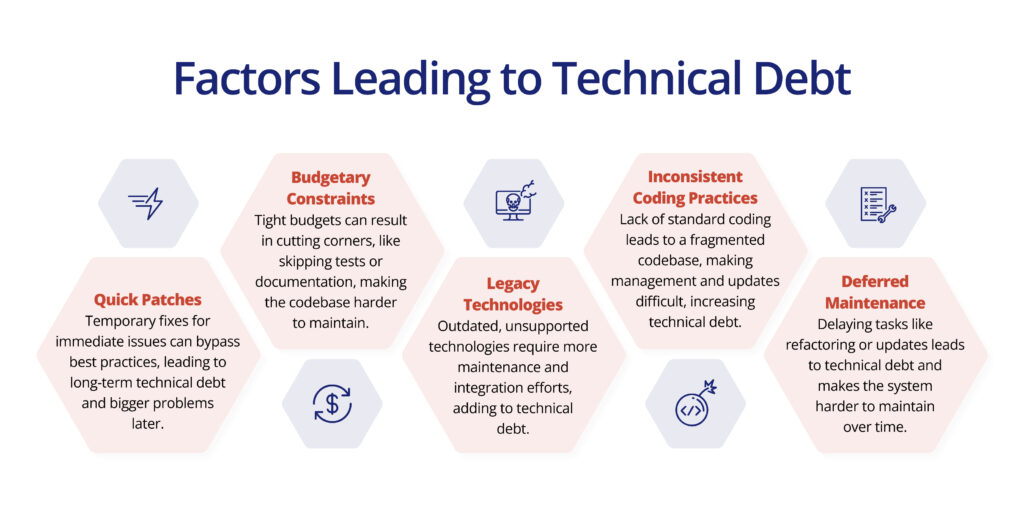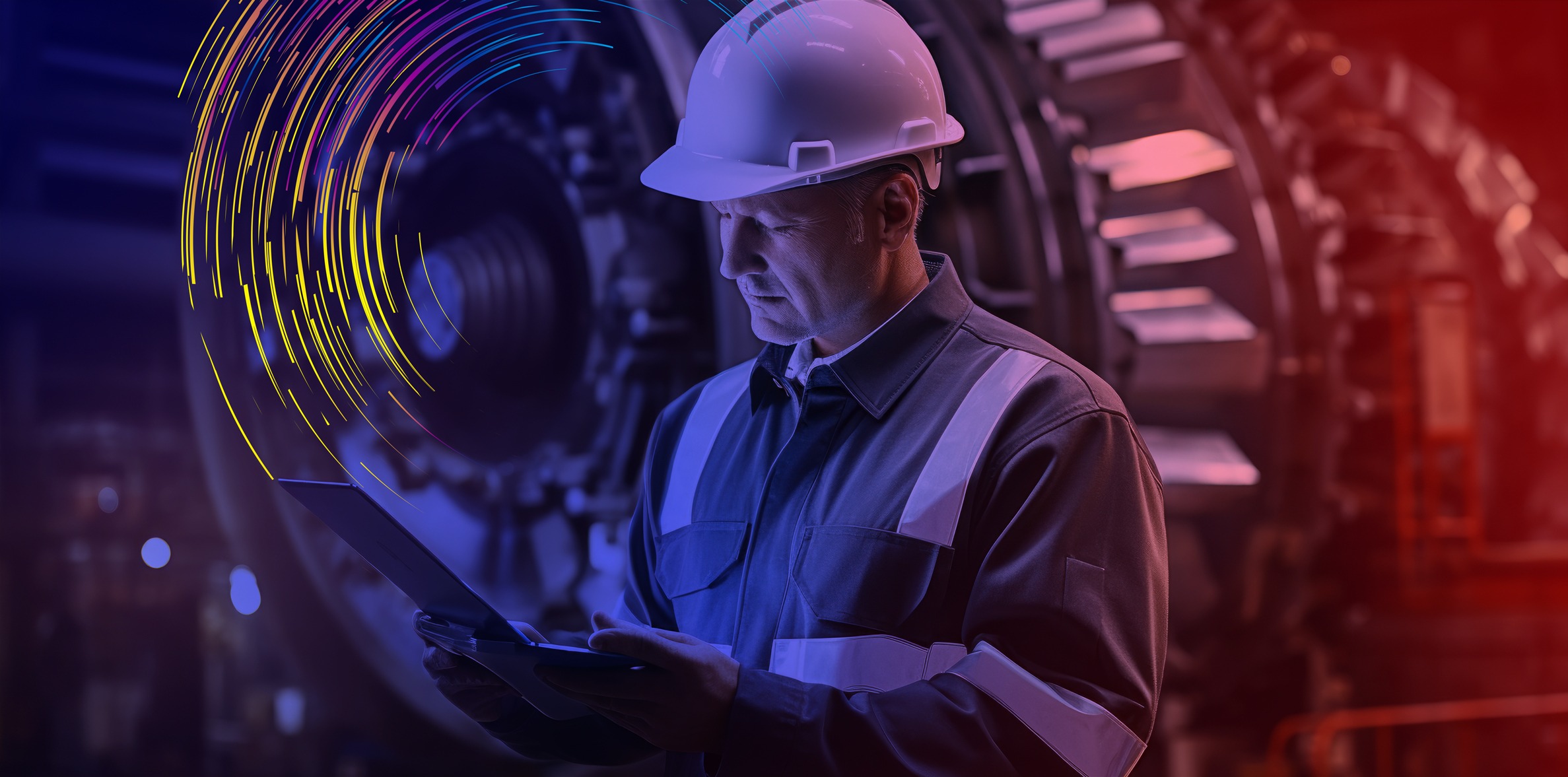Technology is rapidly advancing with innovations like agentic AI, hyper-automation and more, yet many enterprises continue to rely on legacy systems. Maintaining legacy technology costs business up to 30% of their revenue annually, leaving limited resources for strategic initiatives. The technical debt incurred from legacy systems stifle innovation, preventing organizations from adapting to market changes and meeting customer demands effectively.
Enterprise application modernization is essential for staying competitive in today’s digital landscape. Businesses with modernized applications and software consistently achieve greater efficiency, improved customer satisfaction, and a stronger competitive edge. By upgrading legacy applications or migrating to modern cloud-native architectures, organizations can unlock significant benefits, including improved performance, enhanced security, increased agility, and reduced operational costs. However, modernizing enterprise applications requires careful planning due to the complexity of interconnected systems and data.
This guide aims to help organizations navigate the process effectively, ensuring that the modernization efforts not only support business objectives but also set the foundation for long-term success in their digital transformation initiatives.
What is Enterprise Application Modernization?

Enterprise applications are critical software solutions that help organizations manage and optimize their core operations. They generally fall into three categories:
- Core IT Applications: focuses on infrastructure managed by IT teams
- Business Process Applications: streamlines workflows for internal employees
- Customer Support Applications: facilitates and enhance client relationships
These applications are customized to meet specific business needs, and they can quickly become complex and difficult to maintain, especially when operating on legacy systems. This drives organizations to optimize and modernize their enterprise applications.

Enterprise application modernization refers to the process of updating and transforming legacy applications to better align with current business needs and technology trends. This transformation can take various forms, including migrating applications and data to cloud-based platforms, modernizing the application architecture, rewriting code, integrating new technologies, or adopting microservices architecture. The goal is not just to improve performance and user experience but also to enhance flexibility, scalability, and maintainability.
Application modernization technology plays a crucial role in this transformation, enabling organizations to leverage modern software solutions that can offer better functionality, improved security, and greater efficiency than legacy systems. With the rise of cloud computing, containerization, and agile development methodologies, companies can significantly streamline their operations through effective app modernization. Check out our tailored guide to legacy modernization for CTOs.
The Key Challenges in Enterprise Application Modernization

While the benefits of enterprise app modernization are clear, organizations face several significant challenges throughout the process. Identifying these app modernization challenges early can help mitigate risks and pave the way for a successful transition.
1. Legacy System Complexity
Many legacy systems have been built upon decades of iterative development, leading to complex interdependencies. Understanding these systems is often a Herculean task, requiring in-depth knowledge of legacy programming languages and architecture. This complexity can hinder organizations in their efforts to implement app modernization initiatives effectively.
2. Resistance to Change
Cultural inertia can be a significant barrier. Employees accustomed to legacy systems may resist transitioning to new solutions, fearing disruption or a steep learning curve. Addressing this resistance is essential for a successful modernization effort. Effective training programs and clear communication can alleviate concerns and foster a more adaptable workforce.
3. Data Migration
Migrating data from legacy systems to modern platforms poses another significant challenge. Data quality, integrity, and compatibility issues can arise, necessitating meticulous planning and execution. A comprehensive data strategy and application modernization assessment is critical at this stage to identify potential pitfalls in data handling and migration processes.
4. Cost Considerations
App modernization can be cost intensive. Organizations must weigh the upfront costs against the long-term benefits. Finding the right balance is critical to ensure that modernization efforts do not jeopardize current operations or budgets. A thorough financial analysis during the app modernization assessment phase can help determine potential ROI.
5. Security Risks
Legacy systems often lack the robust security features of modern applications, making them vulnerable to cyber threats. During the modernization process, organizations must address these security concerns to protect sensitive data. Implementing modern security protocols as part of the app modernization services can mitigate risks and enhance overall security posture.
What is the biggest driver of application modernization?
The biggest driver of application modernization is the need for greater agility and efficiency. Legacy systems often hinder businesses from responding quickly to market demands and technological advancements. Modernizing applications enables improved performance, scalability, security, and the ability to leverage cloud, data analytics, and automation, helping businesses stay competitive.
Benefits of Application Modernization for Enterprises

Here’s how enterprise app modernization drives significant value for businesses:
1. Enhanced Performance
Modern applications are designed for today’s fast-paced environment. They typically exhibit improved load times, responsiveness, and user interfaces, leading to increased employee productivity and satisfaction. Companies that embrace application modernization technology can unlock these performance benefits, making it easier for teams to collaborate and innovate.
2. Increased Agility
App modernization allows organizations to adopt agile methodologies, enabling them to respond quickly to market changes and customer demands. This agility fosters innovation and a competitive edge. Organizations that modernize their applications can pivot and scale operations more efficiently, aligning with evolving business goals.
3. Improved Integration
Modernized applications often utilize APIs and microservices, facilitating easier integration with other systems, including critical legacy applications and third-party solutions. This interconnectedness is vital for streamlining operations and enhancing overall functionality. The result is a more unified ecosystem that enables businesses to maximize their technology investments.
4. Cost Efficiency
Although modernization may involve significant upfront costs, the long-term savings often outweigh these expenses. Modern applications typically require less maintenance and can be hosted on more cost-effective platforms, such as cloud services. Evaluating costs during the application modernization assessment phase can help organizations identify potential savings over time.
5. Improved Security
By modernizing applications, organizations can adopt the latest security protocols and technologies. This reduces vulnerabilities and enhances the protection of sensitive data. As cyber threats evolve, the need for robust security measures becomes increasingly important, making app modernization not just a strategic choice but a necessity.
What makes a successful application modernization project?
Successful modernization requires clear goals, a structured strategy, and strong leadership. Focus on aligning business objectives with technology upgrades, adopt agile practices, and continuously measure progress. Prioritize user experience, invest in training, and ensure robust testing and monitoring to minimize risks while adapting the system to evolving market demands and technologies.
Enterprise App Modernization Process

Embarking on an enterprise application modernization journey requires a structured approach to ensure successful outcomes. Here’s a step-by-step guide to the modernization process:
Step 1: Assessment and Planning
Begin by assessing the current state of the applications. Identify which systems are outdated, what functions they perform, and how they align with business objectives. Conduct a comprehensive application modernization assessment to evaluate existing infrastructure, user needs, and potential modernization strategies. Engage stakeholders from various departments to gather insights and foster buy-in.
The assessment phase should include:
- Inventory of Applications: List all applications in use, noting their functions, users, and business importance.
- Performance Metrics: Evaluate current performance metrics, including load times, downtime, and user satisfaction.
- Security Review: Assess existing security measures and identify vulnerabilities.
- Cost Analysis: Analyze current operational costs associated with maintaining legacy systems.
By thoroughly understanding the current landscape, organizations can make informed decisions about which applications to modernize and how to proceed.
Step 2: Define Modernization Objectives
Set clear, measurable objectives for your modernization initiative. Determine whether the goal is to enhance performance, improve security, increase user satisfaction, or facilitate better integration with other systems. Establishing these goals will guide decision-making throughout the process. Clearly defined objectives are essential for measuring success and justifying investments in app modernization.
Step 3: Choose the Right App Modernization Strategy
Select the most appropriate modernization strategy based on theassessments and objectives. Common strategies include:
- Rehosting: Moving applications to a new environment without significant changes, often referred to as “lift-and-shift.”
- Refactoring: Modifying existing code to improve performance and maintainability while retaining core functionalities.
- Rebuilding: Completely rewriting applications from scratch to incorporate modern technologies.
- Replacing: Phasing out legacy systems in favor of new, off-the-shelf solutions that better meet current needs.
What is the iterative approach to application modernization?
The iterative approach involves breaking down the modernization process into smaller, manageable phases. Each phase targets specific functions or components for improvement. Regular feedback loops, testing, and optimization throughout the process ensure that the solution evolves effectively, adapting to changes in business needs, technology, and user feedback, while mitigating risks and improving outcomes.

Each strategy has its own set of advantages and trade-offs. For example, while rehosting may be faster and less costly initially, it may not provide the long-term benefits of refactoring or rebuilding.
Step 4: Develop a Roadmap
Create a detailed application modernization roadmap that outlines the timeline, resources, and milestones for the modernization efforts. Break the process into manageable phases, allowing for iterative development and feedback. This phased approach helps to minimize disruptions and provides opportunities for adjustment based on initial outcomes.
Step 5: Execute the Plan
With the roadmap in place, begin the execution phase. This may involve coding, data migration, and testing of new applications. Engage users in the testing process to gather feedback and ensure that the new system meets their needs. Continuous collaboration with stakeholders during this phase is essential for a smooth transition.
Testing is a critical component of the execution phase. Consider implementing:
- Unit Testing: Test individual components to ensure they function correctly.
- Integration Testing: Verify that new applications work seamlessly with existing systems.
- User Acceptance Testing (UAT): Involve end-users in testing to confirm that the application meets their requirements.
By rigorously testing applications before full deployment, organizations can reduce the risk of issues post-launch.
Step 6: Monitor and Optimize
Post-implementation, continuously monitor the performance of the new applications. Collect data on usage, performance metrics, and user feedback to identify areas for further optimization. Application modernization technology can help automate these processes, providing real-time insights into application performance. Modernization is not a one-time event; it requires ongoing adjustments to keep pace with evolving business needs and technological advancements.
Establish KPIs to measure the success of your modernization efforts. Common KPIs might include:
- Load Times: Track improvements in application speed.
- User Satisfaction: Gather feedback through surveys and usage data.
- Cost Savings: Analyze reductions in maintenance and operational costs.
- Security Incidents: Monitor any breaches or vulnerabilities post-modernization.
Step 7: Change Management
Implement a comprehensive change management strategy to address cultural resistance and ensure a smooth transition. Provide training and support to help users adapt to new systems, fostering a culture of innovation and continuous improvement. This investment in change management is vital for long-term success and employee satisfaction.
- Communication: Clearly articulate the reasons for modernization and its benefits.
- Training Programs: Offer comprehensive training sessions to prepare users for the new systems.
- Feedback Loops: Establish channels for ongoing feedback to address concerns and adapt to user needs.
How can enterprise approach application modernization to maximize business value?
Enterprises should assess their current IT industry, prioritize high-impact applications, and leverage cloud and microservices to drive scalability and agility. Adopting an incremental approach with clear milestones, along with continuous collaboration across teams, ensures that modernization aligns with business goals, enhances performance, and improves operational efficiency, ultimately maximizing business value.
Modernize Enterprise Applications with Capten.ai – An AI Software Engineer
Capten.ai’s AI code generation capabilities leverage requirement to code model to generate clean, secure code. From building new applications to modernizing legacy systems, it breaks down monolithic architectures and converts legacy code into modern, scalable microservices. This ensures enhanced performance and compatibility with the latest technologies, paving the way for efficient and future-ready applications.
Enterprise application modernization is a strategic necessity, offering enhanced performance, agility, security, and cost-efficiency. Though challenging, the rewards are substantial. AppsTek Corp specializes in tailored app modernization services, guiding you through each phase and providing ongoing optimization to ensure your applications evolve with your business. Transform legacy systems into agile, secure solutions that drive growth. Contact us to learn more.

About The Author
Ayushi Sharma, Associate Marketing Manager at AppsTek Corp, drives integrated marketing strategy, brand positioning, and multi-channel execution across AppsTek’s technology and Oracle-focused service and solution lines. With experience spanning technology, SaaS, consulting, and digital-first brands, Ayushi brings a broad industry perspective to building structured marketing programs, clarifying narratives, and enabling teams to operate with focus and impact. Her approach emphasizes strategy, alignment, and creating marketing systems that elevate both brand and revenue outcomes.


